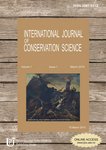 |
Carolina Barata, António João Cruz, Jorgelina Carballo, Maria Eduarda Araújo, "The materials and techniques of polychrome baroque wooden sculpture: three works from Baião, Portugal", International Journal of Conservation Science, 1(1), 2010, pp. 19-26 |
| Abstract |
Three polychrome wooden sculptures, made between the last quarter of the 17th century and the first half of the 18th century, from a monastery in Northern Portugal, representing an episode of the Passion of Christ, were analysed with three aims: to identify the materials and techniques employed; to clarify the relationship between the three sculptures; to reveal previous restorations. Techniques such as radiography, energy dispersive X-ray spectrometry, optical and polarized light microscopy and Fourier Transform infrared spectroscopy were employed. White lead, vermillion, umber, carbon black, gypsum, anhydride and chalk were identified as pigments and fillers. These materials and the layer structure led to the conclusion that sculptures 1 and 2 were treated as a pair of sculptures and that they underwent at least two restorations: the first was probably done in the workshop where they were made. During the second restoration, the heads were replaced. Sculpture 3 is not restored and its poorer style seems to have correspondence to materials of lower quality. |
